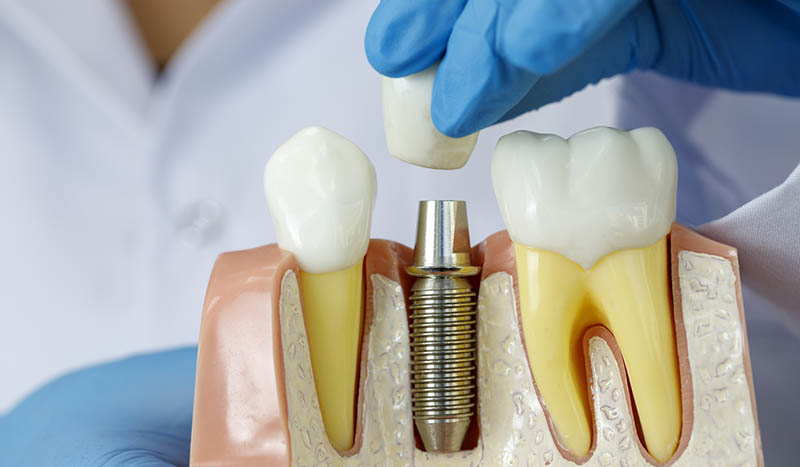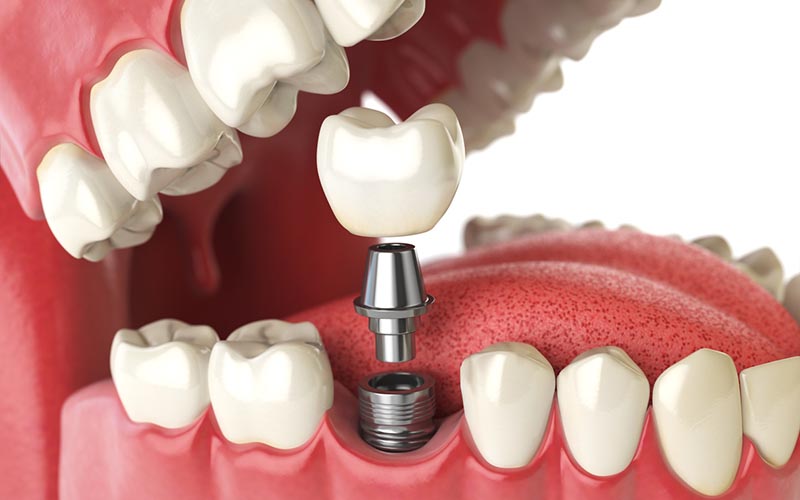The Importance of Oral Health

Whether it’s due to a lack of brushing, skipping regular visits to the dentist or a hereditary issue, you may have noticed that the bones of your jaw are not as strong as they once were. Bone deterioration in your jaw does occur and it can be a potentially dangerous and life-altering condition. Luckily, there is a method to help prevent further bone loss and make sure you’re able to keep your jaw and teeth as healthy as possible. Dental implants are the ideal solution to support your oral health and prevent your jaw and bone density from receding further.
The Dangers of Not Acting Quickly
Sometimes one of the first signs that you’re losing bone density is a missing tooth. Whether it falls out on its own or through an injury, bone density determines how fragile or brittle a tooth becomes. As mentioned before, this loss of density can occur for several reasons, but it can become worse if that tooth isn’t replaced. Without the reinforcing presence of the tooth, the bone in that area actually begins to shrink.
The absence of a permanent tooth makes the density of the surrounding teeth decrease, eventually becoming brittle as well. With time, this causes a destructive cycle in which teeth continue to deteriorate and fall out, further reducing bone density. This occurs again and again until you are basically without teeth and your jaw has eroded away, affecting your ability to chew or speak.
Because of this dangerous cycle, it is critical that you fill those gaps created by a missing tooth as quickly as possible. The longer you wait, the more bone density will be lost and the harder it becomes to insert a dental implant to reinforce your jaw bone.
Bone Grafting to Repair Bone Density
When too much bone density is already lost in the jaw and teeth, some may assume that dental implants might not be an option for them. However, this is not the case. There’s a procedure known as bone grafting that basically adds more bone to certain areas, so dentists can put the dental implant into place.
Initially, dentists will take X-rays to determine the state of decay and how much bone there is. These X-Rays will measure the amount of calcium and other bone materials to determine the state of the density. If it is discovered that you lack enough bone for the implants to be secured, then you do have the option of a bone graft.
The bone grafting procedure involves the process of taking bone from somewhere else and securing it in the desired area. The bone can be taken from a stronger portion of the jaw, the chin, the hip, or even the shinbone. Once the bone is put into place where it is needed, the implant can be installed, preserving your oral health. This procedure has made it possible for countless people to receive implants in an area that would otherwise decay rapidly and leave them with serious dental issues.
The Solution: Dental Implants
All of this comes down to the method of stopping the reduction in bone density. Dental implants are artificial dental roots that are placed into the jaw. They serve to replace missing teeth and fill in gaps that those missing teeth left behind. Implants are attached with crowns and effectively work to preserve jaw structure. They also have the added benefit of functioning just like regular teeth with a natural color and appearance.
There are other cosmetic procedures available to fill missing teeth such as dental bridges or dentures, but these options fail to prevent further bone loss. They do improve the appearance of a patient’s smile but do not affect the jaw or bone density because they are not positioned within the bone as dental implants are.
Dental implants are permanent. As such, they rest in your jaw without you having to worry about them popping out when you’re talking or eating. As mentioned before, they can be used just like regular teeth when it comes to chewing or speaking. Because the implants work similarly to natural teeth, they exert the same amount of force against the jawbone which keeps it healthy and functional. Here’s more on what you can expect after dental implant surgery.
How Dental Implants Work
The science behind dental implants is fascinating. Titanium screws are the secret behind the implant. They’re secured into the jaw by your dentist and a prosthetic tooth or crown caps it all off. The titanium actually fuses with the bone over time which creates an incredibly strong anchor. It’s this relationship and reaction that allows you to use the implant as you would your normal tooth. They can also be used to fill a single missing tooth or multiple missing teeth. So if you’re concerned because the gap in your teeth is particularly large and you may not be able to receive an implant, set your worries aside.
The dental implants are then fitted to your mouth with the use of a mold and 3D imagery. Dentists are able to construct an entire image of your mouth and craft an implant that fits perfectly within the required space. The entire process can take anywhere from three to nine months, but potentially less, depending on how quickly the titanium implant fuses to your jaw bone. Dental implants are more and more affordable as technology progresses. Check with your dentist if your insurance will cover the cost of dental implants.
Seek Help Now
Because of how crucial a role time plays in the decaying of jaw bone density, it’s vital to see your dentist as soon as possible. The last thing you want is to lose the ability to chew or speak properly for the rest of your life because you waited too long to seek professional help. Dental implants are a simple, permanent, and effective means of securing your bone density, facial structure, and preserving your natural oral habits



